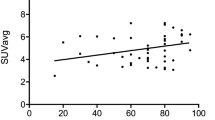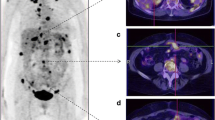Abstract
The aim of this study was to assess the correlation between 18F-fluorodeoxyglucose positron emission tomography (FDG PET) positivity of tumor recurrence and vascularity, Ki-67, p53, and histologic grade in patients with ovarian cancer. Nineteen patients with recurrent ovarian cancer underwent FDG PET before second-look surgery. Archival paraffin-embedded tissue materials were used to assess histologic grade including architectural pattern, mitotic activity, and nuclear pleomorphism; intratumor microvessel density (MVD); Ki-67; and p53. Univariate analysis was used to evaluate the correlation between FDG PET positivity and each biomarker. Stepwise logistic regression analysis was used to determine the best parameter to explain FDG PET positivity. MVD revealed significant positive correlation with FDG PET positivity (p=0.0341). There was no significant correlation between FDG PET positivity and Ki-67 or p53 (p=0.4040, p=0.6027). Mitotic activity yielded statistically significant positive correlations with FDG PET positivity (p=0.0448) although histologic grade revealed no positive correlation (p=1). Stepwise logistic regression analysis revealed MVD to be the strongest parameter for FDG PET positivity (OR=0.696, 95% CI 0.487–0.993, p=0.0458). In conclusion, FDG PET positivity revealed positive correlation with MVD and mitotic activity. MVD was the strongest parameter in predicting positive tumor recurrence on FDG PET.


Similar content being viewed by others
References
Low RN, Barone RM, Lacey C, Sigeti JS, Alzate GD, Sebreachts CP (1997) Peritoneal tumor: MR imaging with dilute oral barium and intravenous gadolinium-containing contrast agents compared with unenhanced MR imaging and CT. Radiology 204:513–520
Coakley FV, Choi PH, Gougoutas CA, Pothuri B, Venkatraman (2002) Peritoneal metastases: detection with spiral CT in patients with ovarian cancer. Radiology 223:495–499
Karlan BY, Hawkins R, Hoh C et al (1993) Whole-body positron emission tomography with 2-[18F]-fluoro-2-deoxy-D-glucose can detect recurrent ovarian carcinoma. Gynecol Oncol 51:175–181
Zimny M, Siggelkow W, Schroder W et al (2001) 2-[Fluorine-18]-fluoro-2-deoxy-d-glucose positron emission tomography in the diagnosis of recurrent ovarian cancer. Gynecol Oncol 83:310–315
Torizuka T, Nobezawa S, Kanno T et al (2002) Ovarian cancer recurrence: role of whole-body positron emission tomography using 2-[fluorine-18]-fluoro-2-deoxy- D-glucose. Eur J Nucl Med Mol Imaging 29:797–803
Cho SM, Ha HK, Byun JY et al (2002) Usefulness of FDG PET for assessment of early recurrent epithelial ovarian cancer. AJR Am J Roentgenol 179:391–395
Nakamoto Y, Saga T, Ishimori T et al (2001) Clinical value of positron emission tomography with FDG for recurrent ovarian cancer. AJR Am J Roentgenol 176:1449–1454
Bristow RE, del Carmen MG, Pannu HK et al (2003) Clinically occult recurrent ovarian cancer: patient selection for secondary cytoreductive surgery using combined PET/CT. Gynecol Oncol 90:519–528
Kubik-Huch RA, Dorffler W, von Schulthess GK, Marincek B, Kochli OR, Seifert B, Haller U, Steinert HC (2000) Value of (18F)-FDG positron emission tomography, computed tomography, and magnetic resonance imaging in diagnosing primary and recurrent ovarian carcinoma. Eur Radiol 10:761–767
Shimizu Y, Kamoi S, Amada S, Akiyama F, Silverberg SG (1998) Toward the development of a universal grading system for ovarian epithelial carcinoma: testing of a proposed system in a series of 461 patients with uniform treatment and follow-up. Cancer 82:893–901
Veit P, Antoch G, Stergar H, Bockisch A, Forsting M, Kuehl H (2006) Detection of residual tumor after radiofrequency ablation on liver metastasis with dual-modality PET/CT: initial results. Eur Radiol 16:80–87
Freudenberg LS, Antoch G, Jentzen W, Pink R, Knust J, Gorges R, Muller SP, Bockisch A, Debatin JF, Brandau W (2004) Value of 124I-PET/CT in staging of patients with differentiated thyroid cancer. Eur Radiol 14:2092–2098
Kallinowski F, Schlenger KH, Runkel S et al (1989) Blood flow, metabolism, cellular microenvironment, and growth rate of human tumor xenografts. Cancer Res 49:3759–3764
Hatanaka M (1974) Transport of sugars in tumor cell membranes. Biochim Biophys Acta 355:77–104
Pauwels EK, Ribeiro MJ, Stoot JH, McCready VR, Bourguignon M, Maziere B (1998) FDG accumulation and tumor biology. Nucl Med Biol 25:317–322
Kurokawa T, Yoshida Y, Kawahara K et al (2004) Expression of GLUT-1 glucose transfer, cellular proliferation activity and grade of tumor correlate with [F-18]-fluorodeoxyglucose uptake by positron emission tomography in epithelial tumors of the ovary. Int J Cancer 109:926–932
Zhao S, Kuge Y, Mochizuki T et al (2005) Biologic correlates of intratumoral heterogeneity in 18F-FDG distribution with regional expression of glucose transporters and hexokinase-II in experimental tumor. J Nucl Med 46:675–682
Munkarah AR, Coleman RL (2004) Critical evaluation of secondary cytoreduction in recurrent ovarian cancer. Gynecol Oncol 95:273–280
Folkman J (1995) Angiogenesis in cancer, vascular, rheumatoid and other disease. Nat Med 1:27–31
Obermair A, Wasicky R, Kaider A et al (1999) Prognostic significance of tumor angiogenesis in epithelial ovarian cancer. Cancer Lett 138:175–182
DiSaia PJ, Bloss JD (2003) Treatment of ovarian cancer: new strategies. Gynecol Oncol 90:S24–S32
Tateishi U, Nishihara H, Tsukamoto E, Morikawa T, Tamaki N, Miyasaka K (2002) Lung tumors evaluated with FDG-PET and dynamic CT: the relationship between vascular density and glucose metabolism. J Comput Assist Tomogr 26:185–190
Veronesi G, Landoni C, Pelosi G et al (2002) Fluoro-deoxy-glucose uptake and angiogenesis are independent biological features in lung metastases. Br J Cancer 86:1391–1395
Folkman J (1971) Tumor angiogenesis: therapeutic implications. N Engl J Med 285:1182–1186
Chen W, Cloughesy T, Kamdar N et al (2005) Imaging proliferation in brain tumors with 18F-FLT PET: comparison with 18F-FDG. J Nucl Med 46:945–952
Choi SJ, Kim JS, Kim JH et al (2005) [18F]3′-deoxy-3′-fluorothymidine PET for the diagnosis and grading of brain tumors. Eur J Nucl Med Mol Imaging 32:653–659
Muzi M, Vesselle H, Grierson JR et al (2005) Kinetic analysis of 3′-deoxy-3′-fluorothymidine PET studies: validation studies in patients with lung cancer. J Nucl Med 46:274–282
Buck AK, Hetzel M, Schirrmeister H et al (2005) Clinical relevance of imaging proliferative activity in lung nodules. Eur J Nucl Med Mol Imaging 32:525–533
Cobben DC, Elsinga PH, Suurmeijer AJ et al (2004) Detection and grading of soft tissue sarcomas of the extremities with (18)F-3′-fluoro-3′-deoxy-L-thymidine. Clin Cancer Res 10:1685–1690
Francis DL, Freeman A, Visvikis D et al (2003) In vivo imaging of cellular proliferation in colorectal cancer using positron emission tomography. Gut 52:1602–1606
Mayr D, Diebold J (2000) Grading of ovarian carcinomas. Int J Gynecol Pathol 19:348–353
Sengupta PS, McGown AT, Bajaj V et al (2000) p53 and related proteins in epithelial ovarian cancer. Eur J Cancer 36:2317–2328
Hernandez E, Rosenshein NB, Bhagavan BS, Parmley TH (1984) Tumor heterogeneity and histopathology in epithelial ovarian cancer. Obstet Gynecol 63:330–334
Lowe VJ, Hoffman JM, DeLong DM, Patz EF, Coleman RE (1994) Semiquantitative and visual analysis of FDG-PET images in pulmonary abnormalities. J Nucl Med 35:1771–1776
Keyes JW Jr (1995) SUV: standard uptake or silly useless value? J Nucl Med 36:1836–1839
Alavi A, Lakhani P, Mavi A, Kung JW, Zhuang H (2004) PET: a revolution in medical imaging. Radiol Clin North Am 42:983–1001
Rosenbaum SJ, Lind T, Antoch G, Bockisch A (2005) False-positive FDG PET uptake-the role of FDG/CT. Eur Radiol 16(5):1054–1065
Acknowledgement
The authors would like to express their appreciation to Dr. Gi Jeong Cheon and Jung Mi Park for their help in reviewing the FDG PET images.
Author information
Authors and Affiliations
Corresponding author
Rights and permissions
About this article
Cite this article
Cho, SM., Park, Y.G., Lee, J.M. et al. 18F-fluorodeoxyglucose positron emission tomography in patients with recurrent ovarian cancer: in comparison with vascularity, Ki-67, p53, and histologic grade. Eur Radiol 17, 409–417 (2007). https://doi.org/10.1007/s00330-006-0326-y
Received:
Revised:
Accepted:
Published:
Issue Date:
DOI: https://doi.org/10.1007/s00330-006-0326-y




